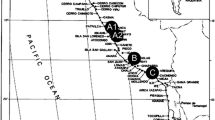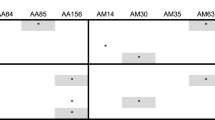Brief summary
In the present account of interspecific crosses in the herbage grasses attention is concentrated on the three annual speciesLolium loliaceum, L. remotum andL. temulentum.
The three have been found to be inter-fertile to the extent that the three possible hybrid types have been obtained as established plants.
L. loliaceum stands clearly apart from the other two species in some of its breeding reactions. With eitherL. remotum orL. temulentum it gave reasonably good seed-setting and high seed germination, but the seedlings developed very abnormally apparently because of lack of co-ordination between the different plant parts.
Apart from all other considerations, the fact that this was common to the hybrids with bothL. remotum andL. temulentum brings these two species into a special class. In addition, these two species are easily intercrossed and theF 1 hybrids develop normally up to pollen formation. It is suggested that failure at pollen formation is caused by gene combinations. This possibility is not entirely removed by the results obtained by using for breeding an odd line (‘L. canadense’) which could not definitely be placed in eitherL. remotum orL. temulentum. A barrier to normal full fertility undoubtedly exists between the two types, but divergence has not yet proceeded very far.
The interaction of the three species with the normally wind-pollinatedLolium types is also reviewed.
I wish to express my gratitude to Mr A. R. Beddows, M.Sc., for invaluable assistance in the execution of the breeding programme; to the present Director of the Welsh Plant Bleeding Station, Prof. E. T. Jones, M.Sc., for providing access to the breeding records and facilities for writing up the work; and to the Agricultural Research Council for providing financial facilities.
Similar content being viewed by others
References
Jenkin, T. J. (1925). Natural crossing in wheat.Welsh J. Agric. 1, 104–10.
Jenkin, T. J. (1935). Interspecific and intergenerio hybrids in herbage grasses. II.Lolium perenne × L. temulentum. J. Genet.31, 379–411.
Jenkin,, T. J. (1936). Natural Selection in relation to the grasses. In ‘A discussion of the present state of the theory of Natural Selection’.Proc. Roy. Soc. B,121, 52–6.
Jenkin, T. J. (1954b). Interspecific and intergenerio hybrids in herbage grasses. V.Lolium rigidum sens. ampl. with otherLolium species.J. Genet. 52, 252–81.
Jenkin, T. J. (1954c). Interspecific and intergenerio hybrids in herbage grasses. VI.Lolium italicum A.Br. intercrossed with otherLolium types.J. Genet. 52, 282–99.
Jenkin, T. J. (1954d). Interspecific and intergenerio hybrids in herbage grasses. VII.Lolium perenne L. with otherLolium species.J. Genet. 52, 300–17.
Jones, E. T. (1933). Natural crossing in oats.Welsh J. Agric. 9, 115–32.
Author information
Authors and Affiliations
Rights and permissions
About this article
Cite this article
Jenkin, T.J. Interspecific and intergeneric hybrids in herbage grasses. Journ. of Genetics 52, 318–331 (1954). https://doi.org/10.1007/BF02981528
Received:
Issue Date:
DOI: https://doi.org/10.1007/BF02981528




